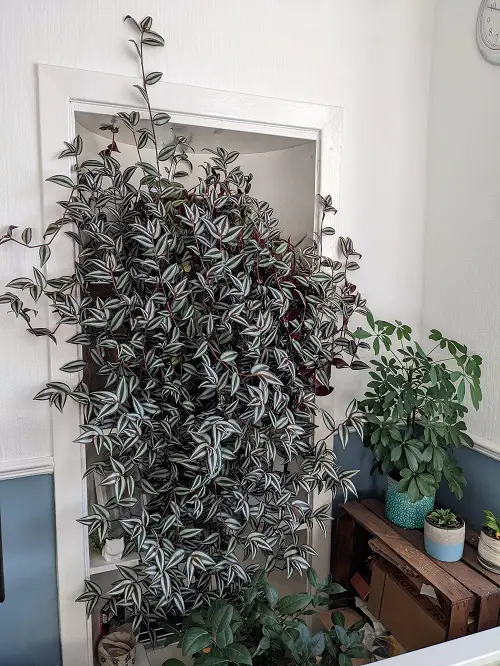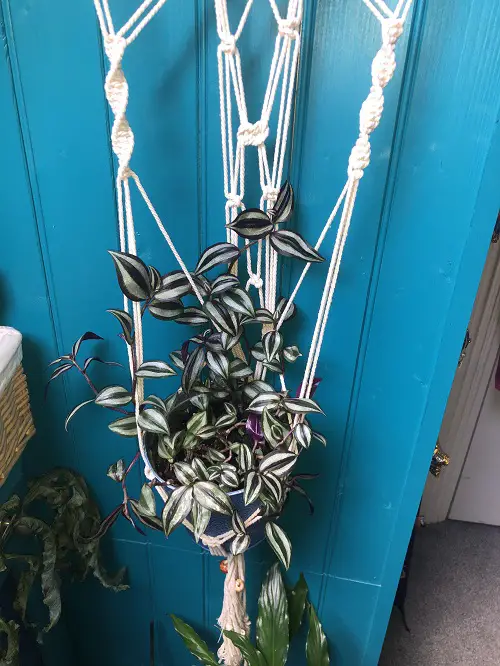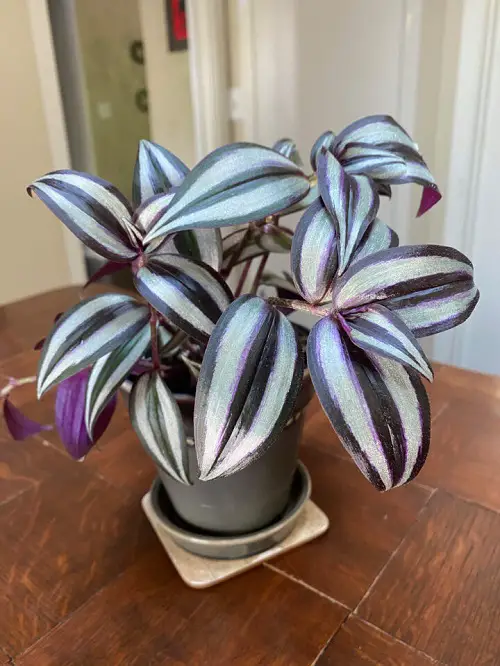With a compelling climbing and trailing habit, we show you How to Grow a Wandering Dude Like a Vine. Read on and try it out!

Also called the inch plant, Tradescantia is a fast-growing creeper with pretty purple, pink, green, and silver foliage, depending more on the variety.
The most popular one, also known as “Wandering Jew or Wandering Dude is considered invasive in many places; this popular houseplant is naturally gifted with long, trailing stems that can be trained to climb or hang like a vine.
With attention to factors such as light, support, and variety, you can train your Tradescantia zebrina to grow like a vine. It’s alright if you hit and miss the first few times, as the process takes a little patience to perfect. But in the end, the reward is a lush plant that you will adore!
How To Grow Wandering Dude Like A Vine
1. Choose the Best Variety
While all wandering dude varieties can be trained to climb, the best ones are Zebrina and Nanouk. Due to their vigorous growth, they are particularly well-suited to train up trellises and topiaries.
Zebrina has many flexible stems that effortlessly intertwine with support structures, and Nanouk offers a compact growth habit but compensates with beautiful and robust stems ideal for training.
2. Support with Appropriate Structure

Tradescantias can grow quite long, but they won’t climb like vines on their own as they are creepers naturally. They need the right kind of support to train and adapt. Let’s see what and how.
- To provide a vertical structure for the plant to climb, you can use a trellis, cords, or wire frame. To install one, simply position it within the plant’s container or garden bed. Gently secure the stems to the structure using soft plant ties or twine.
- Go with moss poles for a natural and beautiful support system for your plant. The fibrous texture of the pole provides an excellent grip for the plant’s aerial roots, enabling it to climb easily. Insert the pole into the plant’s container and gently wrap its stems around it.
- Give it a lattice panel–they provide a large, flat surface for the plant to climb. This option is particularly effective for creating a dense living wall or backdrop. When selecting the dimensions of your lattice panel, consider the desired size and placement of the finished vine wall.
Once you have this, all you have to do is gently train your wandering dude’s stems along the lattice. As the plant grows, continue to guide the stems for even coverage.
3. Use Light to Your Advantage
Light is your secret weapon for shaping your Tradescantia. Strategically place a light source on one side to encourage the plant to grow towards it, creating long, trailing vines. This will help you get the vine-like growth that you’re working for.
You can use grow lights and position them on one side of the plant or shift your plant in a way that it moves toward the natural light. As your plant reaches for the light, its stems will elongate and extend in that direction, giving it a vine-like growth. While doing this, be sure to provide your “dude” ample light, or else it’ll be leggy and less in character.
4. Pruning and Pinching

Pruning is essential to maintain your wandering dude’s vine-like shape and encourage bushier growth. It will help you control the plant’s size, remove leggy stems, and promote new growth.
The best time to prune your warm climate perennial is during its active growth period, typically in spring and summer in cold climates and year-round except peak summer in warm provinces.
Use clean, sharp gardening shears to cut back stems to the desired length. Cut just above a leaf node, where a leaf joins the stem, to drive new growth. Focus on promoting top and upward growth instead of lower growth to train it as a vine. Remove any shoots that grow horizontally or downwards–they’ll make your plant bushy.
Don’t be afraid to prune vigorously; this plant is resilient and will quickly bounce back.
That’s it! Also, take a look at our Tradescantia care guide to ensure your plant stays healthy! Do let us know how it goes for you in the comments below!


